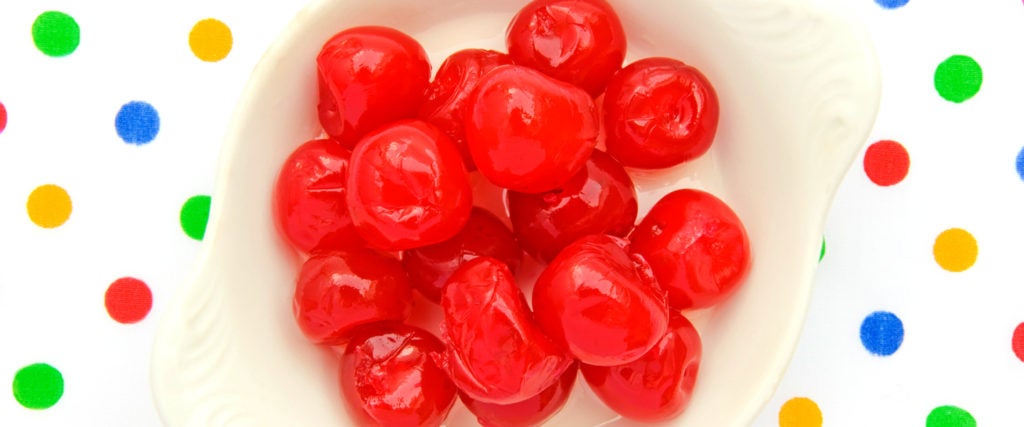The cocktail cherry may be small, but it looms like a fiery red planet over the modern history of eating and drinking. Look, there it is, bobbing around in the rust-brown murk of a Manhattan; and, hey, there it is again nestled in the snowy peak of an ice cream sundae, lurking in the syrup-soaked folds of an upended can of fruit salad, or in your parent’s drinking cabinet, languishing in a sticky jar first opened at the dawn of the Clinton administration.
For more than 100 years it’s been the Zelig of the culinary world, beaming out from multiple places it probably shouldn’t be, inviting you to spear one with a cocktail stick, bite down and let your mouth flood with the unmistakable taste of… well, what exactly?
Not actual, fresh cherries, that’s for certain. No, the taste of a cocktail, glacé or ersatz maraschino cherry has nothing to do with the luscious, grape-like subtlety of real stone-fruit. Its impact on the palate — almonds and preservatives and a great, hallucinatory wash of artificial sweetness — is the flavor profile of a cherry as described by a drunken child. Something that, even way back in 1911, was railed against in a New York Times editorial as “a tasteless, indigestible thing, originally, to be sure, a fruit of the cherry tree, but toughened and reduced to the semblance of a formless, gummy lump by long imprisonment in a bottle filled with so-called maraschino.”
And yet, even though this resistance to the gloopy, synthesized commercialism those little red globules represent is at least a century old, the cocktail cherry abides as a cultural artifact. Not just in the post-Mad Men context of master mixologists hoarding artisanal Luxardo cherries or producing their own housemade varieties, but in studiedly kitsch, revivalist dessert parlors like New York’s Morgenstern’s Finest Ice Cream; and even, scattered throughout Quentin Tarantino’s Once Upon A Time… in Hollywood, garnishing the industrial-strength whiskey sours of one Rick “Fucking” Dalton.
“When you see a bright red one now, it’s like a bartender with a waxed moustache and sleeve garters,” notes Jared Brown, drinks historian and master distiller with venerated British gin brand Sipsmith. “It’s no longer just itself. It’s nostalgia and irony and humor.”
So how does something so ridiculous and occasionally reviled come to have such durable appeal? How the hell are they even made? And what, exactly, do bitter food standardization wars, embalming fluids and carcinogenic food dyes have to do with it?
Well, pour yourself a stiff Mai Tai, crown it with what may be your final ever cocktail cherry, and let’s chart the turbulent life, near-death and eventual resurrection of a near-indestructible American icon.
As with most convenience foods, the cocktail cherry story starts out innocently enough. Cherries stretch back to the prehistory of Europe and West Asia, and pretty much since that time, they’ve been notorious as the frail divas of the produce aisle — difficult to transport, susceptible to bruising and known to liquefy without refrigeration. And so, innovative orchard owners in the early 1800s — most notably the Croatian-born, Italian-based Luxardo family — started preserving at-their-peak cherries, both as an alcoholic liqueur and steeped in a boozy brine made up of mulched cherries, pits and sugar.
This was the Big Bang that gave us the maraschino, named for the sour, Marasca cherry variety that Luxardo made their own. It wasn’t long until these pickled fruits were infiltrating the U.S. as part of the wider mania for cocktails in the mid-to-late 19th century. (The original 1888 recipe for the martini, as Brown notes, called for a “cherry rather than an olive.”) But soon, that original, burgundy-hued Luxardo maraschino was joined by a whole Rothko color wheel of lurid U.S.-made knock-offs, soaked in cheaper preserving syrups.
One reason for this was pure cosmetics. “The first taste is with the eye, and in the days before social media, the maraschino cherry offered a huge visual bounce,” notes Brown. “Think of it resting in the brown tone of a Manhattan — it’s like a bright red beacon in the drink. [And so,] there was a need to get it as brightly colored as possible.”
Yet it’s also notable that the maraschino cherry’s turn-of-the-century ascendancy also coincided with the wider vogue for lab-made dyes, flavorings and additives that flourished in the pre-FDA era. (Relevant: This was also a time when, at the behest of nervous dairy farmers, margarine had to literally be dyed pink in some states to broadcast the fact it wasn’t butter.) “For many years, I’ve asked audiences at tasting events what maraschino cherries, grenadine and sloe gin have in common,” says Brown. “And the answer, of course, is nothing. Nothing! And yet, go back to my childhood and they were all the same color and flavor because they came from the same lab.”
Throw in the arrival of Prohibition in 1920, and the fact it meant fruit could no longer be preserved in alcohol, and other brining methods needed to be found. It was a team of Oregon-based scientists who, after more than five years of experimentation, realized that calcium salts could preserve the Northwest’s seasonal glut of fresh cherries, and also help them retain their firmness. What’s more, in the 1930s, this same team realized that if you bleached the cherries and then dyed them red (or green, or even, occasionally, electric blue) the vivid pop of color would be even more pronounced. At this point, the American “maraschino” — leached of its natural color, embalmed in synthetic preservative and flavored with almond-derived benzaldehyde — had mutated into something only tenuously related to its European forbearer.
The original maraschino farmers in Italy were — if you can believe this — not crazy about American producers using their name to hawk cloying, cherry-shaped candies the color of antifreeze. But by 1940, they had lost a long-stewing food standardization battle, when the FDA decreed that the name “maraschino” had now evolved beyond its original meaning and, to most Americans, meant the artificially flavored neon red scourge of the Luxardo family.
And so, in the wake of World War II, the cocktail cherry’s cultural dominance truly began; slotting into an additive-laced mid-century food landscape, they gleamed from Betty Crocker cake recipes, adorned every other drink at a newly established 1950s Tiki bar chain called Trader Vic’s, and even, come 1978, gave their name to a hardcore adult film called Maraschino Cherry. “I remember adoring them,” says Brown, recalling his 1970s childhood in upstate New York. “There was nothing better, when we were out at a restaurant, than getting a cherry on a little plastic cocktail sword.”
If anything they were even more adored in the U.K., where a collective, post-rationing proclivity for all things sweet only added to their appeal. Eccentric TV chef Fanny Cradock would place them on the top of troublingly phallic “banana candle” party concoctions, and in Only Fools and Horses — a beloved, long-running BBC One sitcom about a family of luckless grifters living in South London — it became synonymous with main character Del Boy and his fondness for gaudy drinks that represented a tacky sort of sophistication. Even when I was growing up in 1990s London, my parents — first-generation Nigerians who rarely drank — would always have a glowing container of what we knew as glacé cherries beside a long-opened bottle of brandy.
“You can’t underestimate the power of a good garnish,” laughs Alice Lascelles, drinks writer and author of Ten Cocktails: The Art of Convivial Drinking. “That Day-Glo cherry is something I associate very strongly with childhood and the idea of a grown-up drink, a celebratory drink.” This mixture of childishness — of innocence — and a more adult glamor seems to be at the heart of the cocktail cherry’s appeal throughout this period toward the end of the last century; they’re fruit with all the subtlety and unpredictability chemically extracted, an unapologetic hit of trashiness that appeals to both Chuck E. Cheese birthday party attendees and the kind of chain-smoking bar flies we all sat two stools from long before social-distancing measures required it.
But, of course, the cocktail cherry party came to an abrupt halt later in the 1980s. Partly, this may have been lingering scares over the occasional use of Red Dye Number 4 — a chemical colorant with some links to cancer in animal trials — in some preserved cherries, permitted because they were deemed to be “decorative” rather than a foodstuff. Also: There were unfounded rumors about formaldehyde being used as a preservative which, perhaps fittingly, just wouldn’t die.
Mostly, though, their waning was linked to the demise of the movement that first popularized them in the U.S. “The maraschino cherry collapsed precipitously along with the collapse of cocktails,” says Brown. “Suddenly, you weren’t finding anyone over the age of 10 lunging toward maraschino cherries, and what happened was people discovered wine, which eventually went into craft beer.”
At that point, in terms of the popular consciousness, cocktail cherries were mostly glimpsed at the fringes of culture, or within insalubrious bars with “C” hygiene ratings tacked to their windows. Then, inevitably, as the cocktail revival of the mid-2000s began in coastal cities, sailor-tattooed mixologists started looking into what preceded the neon cocktail cherries of their youth, and eventually rediscovered Luxardo’s original, burgundy-colored and naturally sweetened maraschinos.
“I remember I’d race [Milk & Honey founder and bartender] Sasha Petrosky and Audrey Saunders [of the Pegu Club] to a place called Dean & Deluca because it was the only place you could buy Luxardo maraschino cherries in New York,” recalls Brown about the frenzy during the craft cocktail boom. “It didn’t matter which one of us got there first; we would end up [dividing] them out until the next shipment.” Now, Brown reports, Luxardo is sending “palette-loads a week over” for import and he himself preserves around 200 jars of maraschino-style cherries a year to sell from his home in the English countryside. In 2017, Luxardo planted 2,000 new Marasca cherry trees in Northern Italy — taking their total to 30,000 — just to keep pace with demand.
The pendulum, after all those years of traffic light-red candied cherries, has swung back to something purer again. Yet, interestingly, the unnatural cocktail varieties haven’t disappeared. They’ve had their own rebirth, whether crowning old school cocktails at acclaimed, 1960s-inspired Detroit bar Hammer and Nail, or clogging social media feeds as part of author Anna Pallai’s Twitter account-turned-campy-coffee-table-hit 70s Dinner Party. “There’s a definite trend for kitsch that’s brought them back,” says Lascelles. “Instagram has helped as well, because they really pop in a picture.”
It makes sense that the current, extremely online moment — where almost everything can be both completely sincere and larded in multiple confusing layers of irony — would be the time when both these diametrically opposed approaches to cherry preservation would find room to flourish. They are, as Brown notes, “jubilant and ebullient at a time when humor and fun is something we are all desperate for.” It seems as plain as the unearthly red glow, beaming from the bottom of a filled coupe glass in the corner. Like that opened jar in your parents’ home bar, the cocktail cherry isn’t going anywhere.

